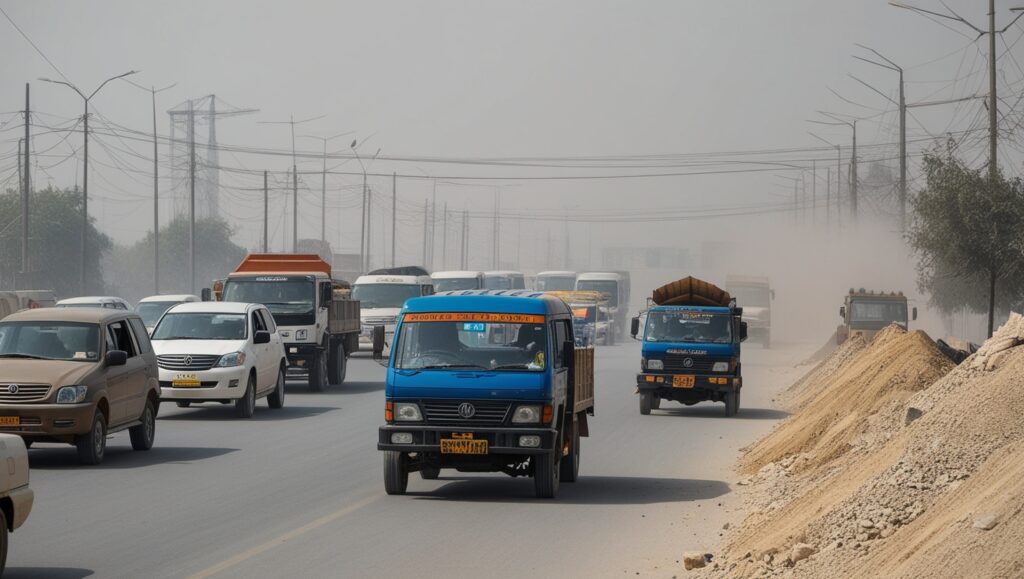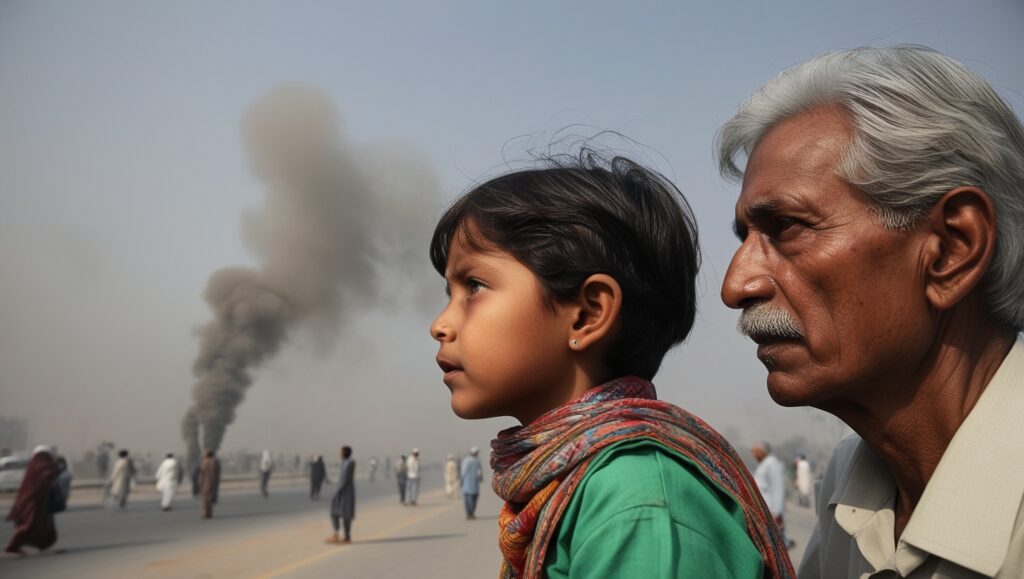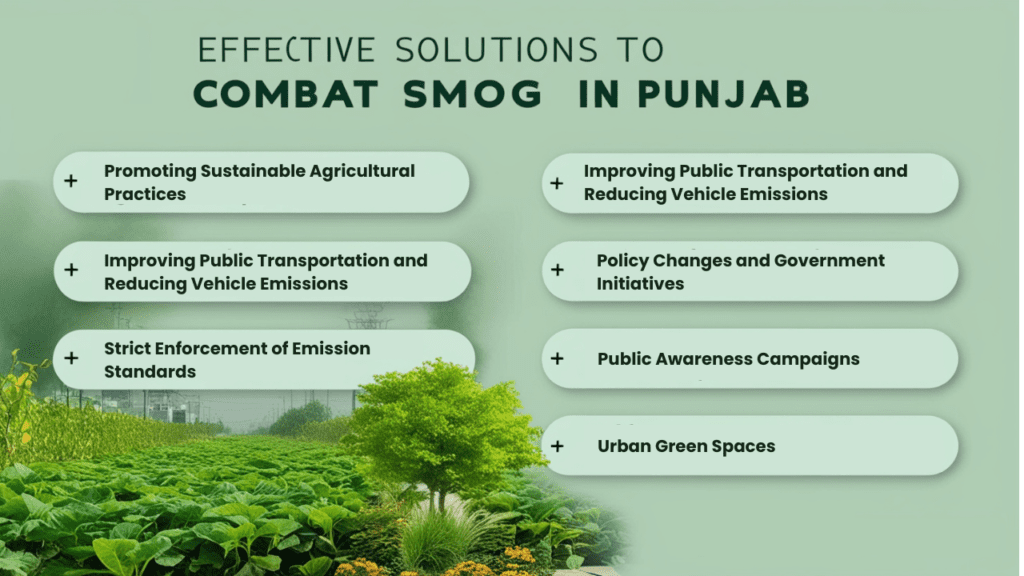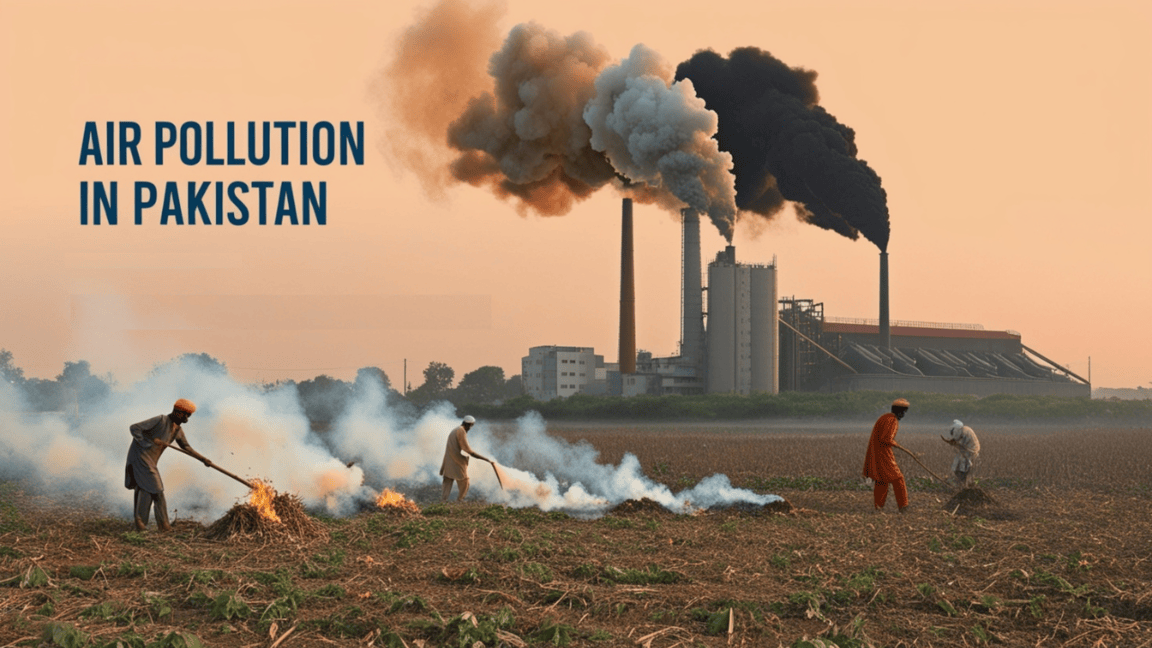Smog in Punjab is a growing environmental and health issue that affects millions across the province. Particularly in the winter months, the pollution levels rise drastically, creating a health crisis that affects cities like Lahore, Faisalabad, Rawalpindi, and others. Understanding the causes, health risks, and effective solutions is crucial for individuals, policymakers, and communities to combat this pressing issue.
Causes of Smog in Punjab

The causes of smog in Punjab are varied and interconnected, involving both human activities and natural environmental factors. Here’s a deeper dive into each of these causes:
- Agricultural Practices
Punjab is known as the “breadbasket” of Pakistan, producing a significant amount of the country’s crops, especially rice and wheat. One of the key agricultural practices contributing to smog in the region is the burning of crop residue after harvesting, particularly in rice fields. During the rice harvesting season, farmers often burn rice straw to quickly clear fields for the next planting cycle. This release of smoke, particulate matter, and harmful chemicals into the air forms one of the primary causes of smog in Punjab.- Impact: According to some estimates, crop burning contributes to 30-40% of the smog in the region. This activity is particularly severe during October and November when air quality deteriorates drastically in Punjab.
- Solution: Adopting sustainable agricultural practices, such as using crop residue for bioenergy production, composting, or incorporating it into the soil, can drastically reduce the need for burning. The government can incentivize farmers with subsidies or equipment to manage crop residues without burning them.
- Industrial Emissions
Punjab’s rapidly growing industrial sector, including textile mills, cement plants, and chemical factories, is another major contributor to smog. These industries release harmful pollutants such as sulfur dioxide (SO₂), nitrogen oxides (NOₓ), and particulate matter, all of which play a significant role in smog formation.- Impact: Factories in industrial hubs like Faisalabad, Lahore, and Multan contribute to a substantial portion of air pollution in Punjab. Without strict enforcement of environmental standards, industrial emissions continue to worsen smog levels, especially during the colder months when pollutants remain trapped in the atmosphere.
- Solution: Strengthening environmental regulations, enforcing emission standards, and transitioning industries to cleaner technologies are vital steps. Industries should adopt cleaner alternatives like renewable energy and pollution-control technologies to minimize their carbon footprint.
- Vehicular Emissions
The increase in the number of vehicles on the roads, particularly in urban areas like Lahore and Rawalpindi, is a significant cause of smog in Punjab. Diesel-powered vehicles, in particular, emit high levels of carbon monoxide, nitrogen oxides, and particulate matter, all of which contribute to the formation of smog. The increasing urbanization and reliance on private vehicles further exacerbate this issue.- Impact: The transportation sector is responsible for a considerable share of air pollution in cities like Lahore, where traffic congestion and poorly maintained vehicles contribute to the rising pollution levels.
- Solution: Expanding and improving public transport infrastructure is one of the most effective solutions. Lahore, for example, could benefit from an expanded metro network, better bus services, and incentivizing the use of electric vehicles. Additionally, enforcing vehicle emission standards and encouraging regular vehicle maintenance can reduce pollution.
- Construction Dust
Construction activities, particularly in rapidly developing cities, add to the air pollution in Punjab. Dust from construction sites, along with the use of heavy machinery, releases large amounts of particulate matter into the atmosphere.- Impact: In urban areas, the dust created from construction sites contributes to higher pollution levels, worsening smog conditions. This problem is particularly evident in Lahore, where large-scale infrastructure projects are ongoing.
- Solution: Implementing dust control measures such as water sprinkling on construction sites, covering construction materials, and restricting work during high-pollution days can help reduce the contribution of construction dust to smog.
- Geographical Factors
Punjab’s unique geographical features also contribute to smog formation. The province is located in a basin-like area, surrounded by mountains, which traps pollutants during colder months, particularly when temperature inversions occur. These inversions prevent the dispersion of pollutants, allowing smog to linger for extended periods.- Impact: During the winter season, the combination of temperature inversion and high levels of pollutants leads to severe smog events that can last for days, severely affecting visibility and air quality.
- Solution: Long-term solutions involve better urban planning and the development of green spaces that can help in absorbing pollutants. However, addressing geographical factors requires a combined effort with meteorologists and urban planners to design strategies that minimize the trapping of pollutants.
Health Risks of Smog

Smog in Punjab has profound health impacts, particularly for vulnerable groups such as children, the elderly, and people with pre-existing health conditions.
- Respiratory Problems: Prolonged exposure to smog aggravates conditions such as asthma, bronchitis, and Chronic Obstructive Pulmonary Disease (COPD). Fine particulate matter (PM2.5) can penetrate deep into the lungs, causing inflammation and difficulty breathing.
- Cardiovascular Risks: Smog increases the risk of heart attacks, strokes, and other cardiovascular diseases. Long-term exposure can lead to an increased burden on the healthcare system due to rising cases of heart-related illnesses.
- Eye and Skin Irritation: The pollutants in smog, including sulfur dioxide and nitrogen oxides, can cause eye irritation, leading to burning sensations, redness, and even long-term damage to the eyes. Skin irritation and rashes are also common.
- Weakened Immunity: Exposure to pollutants can weaken the immune system, making individuals more susceptible to infections such as colds, flu, and respiratory infections.
- Vulnerable Populations: Children, due to their developing lungs, and the elderly, whose immune systems are weakened, are particularly at risk. Studies have shown that smog exposure in children can stunt lung development, leading to chronic health issues in later life.
Effective Solutions to Combat Smog in Punjab

- Promoting Sustainable Agricultural Practices
Encouraging the use of bioenergy, mulching, and other non-burning practices for managing crop residues can help reduce the harmful effects of crop burning. Educational programs and government subsidies could motivate farmers to adopt these practices. - Improving Public Transportation and Reducing Vehicle Emissions
Expanding public transportation networks and incentivizing the use of electric vehicles can drastically reduce vehicular emissions. Additionally, the introduction of stricter vehicle emission standards and the promotion of carpooling can further reduce pollution from this source. - Strict Enforcement of Emission Standards
The government must ensure strict enforcement of emission standards for industries and vehicles. Introducing penalties for non-compliance, as well as rewarding clean practices, could significantly reduce smog-causing pollutants. - Urban Green Spaces
Expanding urban green spaces such as parks, trees, and vertical gardens can help absorb pollutants and improve air quality. These spaces not only provide health benefits but also offer aesthetic value to urban environments. - Public Awareness Campaigns
Public awareness campaigns that educate citizens about the health risks of smog and encourage environmentally friendly practices can have a profound effect. Schools, community centers, and local media can be powerful platforms for spreading this crucial information. - Policy Changes and Government Initiatives
The government must prioritize policies that address the root causes of smog. This includes providing incentives for cleaner industries, promoting renewable energy sources, and developing stricter environmental laws.
Read about Punjab Clean Air Action Plan.
Conclusion
Smog in Punjab is a complex problem with far-reaching consequences, but it is not insurmountable. By understanding its causes and health impacts, and by implementing effective solutions, we can reduce air pollution and create a healthier, cleaner environment for future generations. The fight against smog requires the collective efforts of the government, industries, and the public to ensure cleaner air and improved quality of life for all.
Frequently Asked Questions about Smog in Punjab
1. What is smog in Punjab and why is it a problem?
Answer: Smog in Punjab is a severe air pollution phenomenon that occurs primarily during the winter months, caused by a mixture of pollutants like particulate matter, nitrogen oxides, sulfur dioxide, and other harmful chemicals. The major contributors to smog include agricultural burning (especially rice residue), industrial emissions, vehicular pollution, and construction dust. Smog poses serious health risks, including respiratory problems, cardiovascular issues, and eye irritation, and it negatively impacts the environment and quality of life in cities like Lahore, Faisalabad, and Rawalpindi.
2. What causes smog in Punjab?
Answer: Smog in Punjab is mainly caused by:
- Agricultural Practices: Farmers often burn rice and wheat residue to clear fields, which releases smoke and particulate matter into the atmosphere.
- Industrial Emissions: Factories and plants release harmful pollutants like sulfur dioxide and nitrogen oxides.
- Vehicular Emissions: The increasing number of vehicles, especially diesel-powered ones, contribute to smog by releasing carbon monoxide and hydrocarbons.
- Construction Dust: Ongoing construction activities add dust particles to the air, exacerbating smog.
- Geographical Factors: Punjab’s geography, particularly temperature inversions, traps pollutants, preventing smog from dispersing.
3. How does smog affect human health in Punjab?
Answer: Smog in Punjab can have serious health impacts, particularly for vulnerable groups:
- Respiratory Problems: Smog aggravates asthma, bronchitis, and chronic respiratory diseases like COPD.
- Cardiovascular Issues: Prolonged exposure to smog increases the risk of heart attacks and strokes.
- Eye and Skin Irritation: Pollutants in smog can cause red, irritated eyes and skin rashes.
- Weakened Immunity: Continuous exposure weakens the immune system, making individuals more susceptible to infections.
- Children and Elderly: Smog affects children’s lung development and can lead to severe complications in the elderly.
4. What are some effective solutions to reduce smog in Punjab?
Answer: There are several solutions to combat smog in Punjab:
- Promoting Sustainable Agricultural Practices: Encourage farmers to avoid crop burning by adopting alternative methods like composting or using crop residue for bioenergy.
- Improving Public Transportation: Expanding and enhancing public transport systems can reduce emissions from private vehicles.
- Stricter Emission Standards: Enforcing stricter environmental regulations for industries and vehicles can significantly reduce pollution levels.
- Developing Urban Green Spaces: Expanding green spaces like parks and trees can help absorb pollutants and improve air quality.
- Public Awareness Campaigns: Educating the public about the health risks of smog and encouraging eco-friendly practices can help reduce pollution.
5. How can the government help reduce smog in Punjab?
Answer: The government can play a crucial role by:
- Implementing Strict Environmental Policies: Enforcing stronger emission standards for industries and vehicles.
- Promoting Cleaner Technologies: Incentivizing industries to adopt clean and renewable energy sources.
- Supporting Sustainable Agriculture: Providing subsidies and education for farmers to reduce crop residue burning.
- Investing in Public Transport: Expanding public transport options to reduce vehicular emissions.
- Raising Public Awareness: Conducting campaigns to educate the public about smog’s harmful effects and preventive measures.
6. When is smog the most dangerous in Punjab?
Answer: Smog in Punjab is typically most dangerous during the winter months, from October to December. During this time, temperatures drop, and temperature inversions trap pollutants near the ground. This leads to prolonged smog episodes, particularly in urban areas. These conditions are worsened by the burning of crop residue during the rice harvesting season and industrial emissions.
7. What can individuals do to protect themselves from smog in Punjab?
Answer: To protect yourself from the harmful effects of smog:
- Limit Outdoor Activities: Stay indoors during heavy smog days, especially in the morning and evening.
- Use Air Purifiers: If possible, use air purifiers in your home to filter out pollutants.
- Wear Masks: Use N95 masks that can filter out fine particulate matter when going outside.
- Monitor Air Quality: Stay informed about air quality levels and avoid unnecessary outdoor exposure on bad air quality days.
- Improve Indoor Ventilation: Ensure proper ventilation at home to prevent indoor air pollution buildup.
8. How is smog in Punjab different from regular air pollution?
Answer: Smog is a specific type of air pollution that occurs when pollutants like particulate matter, sulfur dioxide, and nitrogen oxides combine under certain weather conditions, typically in winter. While regular air pollution can occur throughout the year, smog is a more severe form of pollution that forms under specific weather conditions like temperature inversions. It leads to thicker, more hazardous air that is harder to disperse, and its health impacts are typically more immediate and severe.
9. Is there any legislation to control smog in Punjab?
Answer: Yes, the Punjab government has introduced several regulations to address air pollution and smog. These include enforcing emission standards for industries and vehicles, promoting cleaner technologies, and regulating crop burning. However, enforcement remains a challenge, and stricter policies, along with greater public awareness and compliance, are needed to reduce smog effectively.
10. Can reducing smog in Punjab improve the environment?
Answer: Yes, reducing smog can significantly improve the environment. Lower pollution levels would lead to better air quality, which can help reduce acid rain, improve the health of ecosystems, and enhance the quality of life for residents. Additionally, cleaner air would reduce the burden on healthcare systems, improve visibility, and contribute to a more sustainable environment.









[…] Click here to read our previous blog post. […]